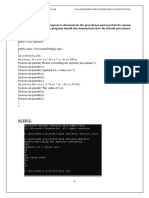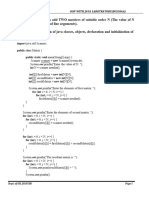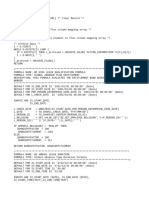0% found this document useful (0 votes)
40 views24 pagesOops-Java-Lab Manual
The document discusses Java programs and classes for matrix addition, stacks, employee details with salary raises, point coordinates, and shapes/polygons with subclasses demonstrating polymorphism. It includes code examples for classes like Matrix, Stack, Employee, MyPoint, and abstract class Shape with Circle, Triangle, and Square subclasses.
Uploaded by
Aarthi KumarCopyright
© © All Rights Reserved
We take content rights seriously. If you suspect this is your content, claim it here.
Available Formats
Download as PDF, TXT or read online on Scribd
0% found this document useful (0 votes)
40 views24 pagesOops-Java-Lab Manual
The document discusses Java programs and classes for matrix addition, stacks, employee details with salary raises, point coordinates, and shapes/polygons with subclasses demonstrating polymorphism. It includes code examples for classes like Matrix, Stack, Employee, MyPoint, and abstract class Shape with Circle, Triangle, and Square subclasses.
Uploaded by
Aarthi KumarCopyright
© © All Rights Reserved
We take content rights seriously. If you suspect this is your content, claim it here.
Available Formats
Download as PDF, TXT or read online on Scribd
/ 24
























































































